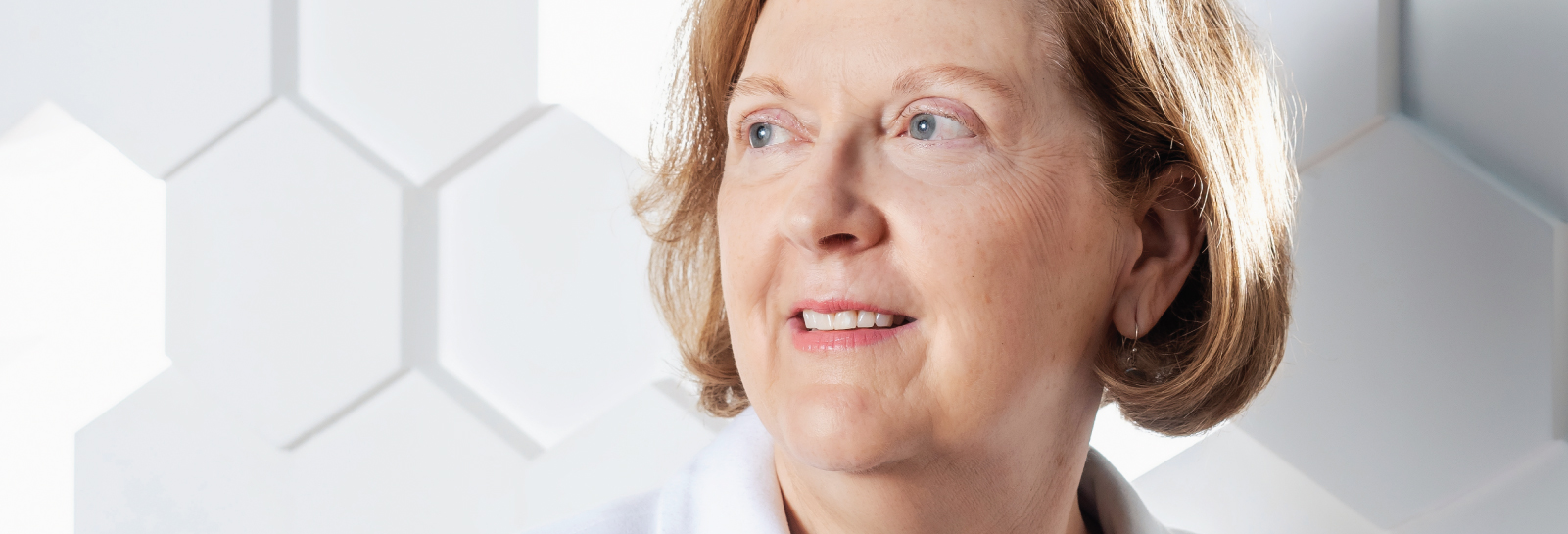Persistence isn’t just a virtue. In the experience of Beth Hampton, vice president of marketing and communication for AACC, it’s a must-have quality for leading an association in the modern era.
Persistence means seeing good ideas to their peak, even if there are deep valleys—from shaky technology to shifting stakeholder opinions—along the way. It means never giving up on what you know is a sound strategy, even if you have to rethink how you pitch it to fellow decision-makers. It means ongoing, meticulous analysis of your processes and models that never truly finishes.
Fortunately, Hampton says, she has always worked for organizations that support persistence and the entrepreneurial spirit that comes with it. Since 2012, she has been with AACC, a global professional association dedicated to clinical laboratory science and more than 50,000 clinical laboratory professionals, physicians, research scientists and business leaders. Hampton has served in various association leadership roles for the majority of her career, including positions at The Optical Society and the American Chemistry Council.
Q: What are the most significant changes you’ve observed in your years of driving marketing innovation in the world of associations?
Well, certainly competition has increased from not only other associations but other for-profit groups. So associations have to be more competitive than ever before, have to be more entrepreneurial than ever before and certainly more innovative.
It’s always been my experience to work with really forward-thinking, strategic, inspiring people. And it’s the members who make it that way. They help create the culture of these associations that are so vibrant and never really resting on their laurels. How can we be more relevant, not only to our current constituency but where things are headed in our field? It has worked for trade associations and professional societies, and I think those things that I just said apply to both types of organizations.
Q: Are there distinctions? Are there certain things that have changed that apply more to trade associations versus professional societies, for example?
Within a trade association, of course, members of the institution and the institutions obviously are the main stakeholders, but you have to engage multiple contacts within those associations and within those institutions. In a professional association, you have many, many more direct stakeholders that are all primary because they’re not only members, but also you have other programs that support the associations. So nonmember customers may have equal value to paying member customers as well.
Q: With that in mind, what’s your experience at AACC with the focus on members versus shifting your services to the larger industry?
Maybe 10 years ago, pretty much everybody followed the same type of model for membership categories. And now, it should be really relevant to your particular profession or field or industry. You really have to look at the membership model that’s going to work for your constituency, in terms of types of membership engagement, types of membership categories and how you’re going to charge people for that level of engagement.
In my seven years, we’ve actually been looking at membership several times. We don’t formally review it every single year, but we’re constantly reviewing it because we just always want to make sure that we are relevant, that people are finding some satisfaction, great engagement, quality or all of those with their membership in AACC. We’ve made some formal changes to our categories, dues structure and benefits. It’s just an ongoing process now. We don’t ever say, “Put it in the drawer. We’re done.”
Q: What is something that has worked, that you’ve measured and said, Let’s keep doing this?
We launched a category called express membership a couple of years ago. It’s not just about membership. We are already expanding our focus beyond just clinical chemists in the lab management profession. We are that big tent. We encompass all professionals who are health care folks in the clinical laboratory setting. And so, as a result, we have expanded a lot of our programs to be more comprehensive. We wanted to engage more people, but since our identity for 75 years has been solely on clinical chemistry, our brand was all about clinical chemists.
So we created the express category to give these folks whose primary role may be something other than as a clinical chemist, but to be part of AACC and get access to some of the benefits and services that are offered. And then, if they like what they see and they like what they’re experiencing as an express member—which has a lower membership dues level but also doesn’t include all the membership benefits—then hopefully they may find that these other services and benefits are equally appealing and then upgrade. Or they may always stay an express member, and that’s fine too because we want them to be part of this bigger community.
Q: How else have you been expanding the tent?
We have our flagship magazine, Clinical Laboratory News (CLN), and its related brand, CLN Stat. And those have readerships far beyond our membership levels. We have health care professionals from across the laboratory medicine professional spectrum and other health care professionals.
And then we have our annual scientific meeting that exceeds the members. Those are primarily professionals who are working in clinical laboratories as well as those on the industry side who are providing instruments and other kinds of lab instruments and related software and related hardware and things that will be relevant for the clinical lab setting. So we’re getting a lot of nonmembers engaging with the AACC, but in terms of health care categories, you name it, and there is a role for them in diagnostics.
Q: I know you’ve made some basic branding shifts along those lines, too. One of them explains why we keep using the acronym AACC versus the full legal name of your organization, American Association for Clinical Chemistry. Can you explain the thinking?
We want to make sure that we cover all professional levels of those who work in the lab, work with lab professionals or work with both. The name “clinical chemistry” is important to us because it’s our history, and clinical chemists are our members, but it’s also limiting in that it doesn’t seem inclusive of other health care professionals, many of whom are our members. Their professional backgrounds are not necessarily in clinical chemistry. Even in our leadership, we had people on the board who weren’t necessarily clinical chemists.
The word “American” was also somewhat misleading because we are a global enterprise now. Thirty percent of our members come from outside the U.S. So we, like many associations, rather than choosing a different name, we adopted the use of the acronym to retain the brand strength that we’ve accomplished in 75 years.
Q: A lot of this shifting has to do with thinking about your core traditional audience versus people you’re trying to reach. How do you think about that balance?
It’s almost programmed. So for example, our annual scientific meeting is a very significant program for a lot of reasons. It’s highly visible, and it attracts a great deal of people. It has venues not only for education but also the show floor. So people are gathering to get to the latest technologies and instruments and things of that nature. Certainly there is great science presented, and the media are interested.
We spend a lot of time on how to make sure the broader professionals at every level, from lab professionals to other health care professionals, physicians, industry players, hospital administrators—every facet of anybody who’s in that health care enterprise that may have some interest in diagnostics—receives an invitation, knows this event is happening and knows about attractive offerings that may boost attendance.
Our strategic plan encompasses how not just to get those eyeballs on reading our publications, but what can we offer that’s relevant to them and also relevant to our core audience? So we’re looking at that Venn diagram: What’s that sweet spot that’s appealing to more than one group? And there’s more than one group. It may be members. May be nonmembers. And it could be “ands” or “ors.” So I think we’re looking for the “ands,” not the “ors.”
Q: How does that approach affect your approach to governance and volunteers?
We also redid our governance. We had a task force of our leadership that was focused on doing an examination of our governance processes and structure. And this task force did a phenomenal job of this assessment and its overall evaluation and came forward with some very good recommendations to the board of directors. So it didn’t happen overnight. We kept members informed. We kept the board informed, of course. They were lockstep part of the process. And then, when the recommendations were made, certainly there were some bylaws, changes that had to be put forth to the membership to approve.
Every step of the way, we were communicating with members on how these changes were going to impact AACC for the better. One of the big goals was to create more opportunities for more members to be engaged as volunteers. We’re in our third year now of the new governance process, and it’s working fantastically. We have more members. We have more opportunities for members. We have more members from a variety of backgrounds that are involved with the governance.
Q: Have any ideas or initiatives come from that new structure that you think have been particularly successful?
We have a lot of committees. But I worked directly with one called the Clinical Laboratory Scientists Council. This faction was a brand new group. They represent supervisors and managers in the laboratory and can be of a variety of specialists or generalists. They’ve created a host of programs including educational initiatives to a happy hour, which doesn’t sound like a lot, but pre-Council, guests at the annual scientific meeting didn’t have a social outlet of this kind.
Additionally, each year, we have an expert floor tour in which attendees select a topic. Last year, the theme was analyzers. We picked 12 exhibiting companies for them to visit, and they were able to have a customized expo floor tour. This year’s theme is data analytics. Our annual meeting is a huge trade show, with over 800 exhibitors. So having this level of focus and engagement for such an important audience is really nice, and it has been a success.
Q: You’ve also mentioned being entrepreneurial. From that perspective, what things are you most proud of that you’ve implemented for either member benefits, content or any other part of your association?
I see the Artery as a huge success story. This forum started in 2013. Part of the strategic plan was to not define the online community, but find another way for members to engage when they’re unable to travel.
So this idea of an online community started in 2013, and we experimented for about a year or two. We started with old-fashioned Listservs, around 14 of them. They were clunky. It really took us about two years to get it right, to what we have now. We didn’t give up because we knew that we needed not only the best kind of software but ways for people to communicate.
Now, we have over 40 online forums, plus our general open forum—and it’s hugely successful. That’s a form of entrepreneurship. You don’t give up. You may have the idea and you may have a catalyst behind it, but you don’t always start out with what makes it work right from day one.
Q: Are there any big ideas you just haven’t been able to tackle yet?
Well, I actually had a wish come true. It has been my goal since year one to implement marketing automation here. I believe strongly in marketing automation. It is the way to customize content, customize messaging and give people their own unique experience that they desire. It’s not new, but we did not have the right tools to be able to offer that to members and other stakeholder individuals. I have been trying to get marketing automation implemented here for a very long time, and 2019 is the year that we’re making it happen.
I have not given up. I knew it would happen, but I had to persevere. It has been at the top of my goals list every single year.
Q: What is your advice to your colleagues on sticking something out when you really do believe that it’s worth the effort?
Just keep trying new ways of bringing it forward. Be the broken record, but don’t be such a broken record that people have heard the same pitch from you that they are now no longer paying attention to how you’re saying it. I probably approached it 10 different ways over six years. Maybe the 10th time is the charm.
Q: Congratulations. You must be especially proud. You defied the odds, persevered and pulled it off.
I am. It’s such an unsexy thing. If I was in a job interview and somebody asked me that, I’m not even sure I would use it because who cares, you know? It’s technology. But technology is the enabler for so many things that we want to do.




